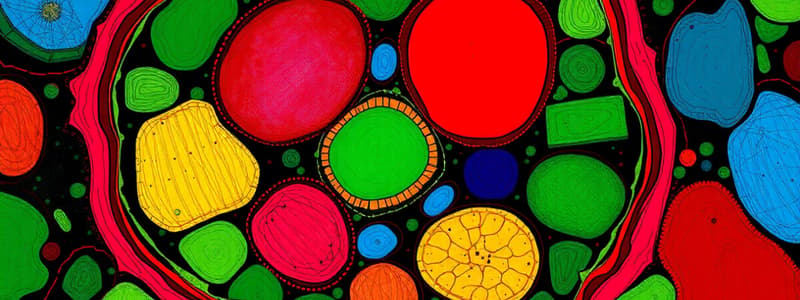Podcast
Questions and Answers
What is the primary function of the cytosol within the cytoplasm?
What is the primary function of the cytosol within the cytoplasm?
- Site for chemical reactions and osmoregulation (correct)
- Transportation of nutrients within the cell
- Storage of genetic material
- Energy synthesis for metabolic processes
Which of the following statements accurately describes cytoplasmic organelles?
Which of the following statements accurately describes cytoplasmic organelles?
- They are small, insoluble particles in the cytosol.
- They mainly consist of liquid-like substances.
- They are solely responsible for energy synthesis.
- They carry out specific tasks for the cell. (correct)
Which type of organelle is responsible for photosynthesis?
Which type of organelle is responsible for photosynthesis?
- Mitochondria
- Chloroplasts (correct)
- Nucleus
- Endoplasmic Reticulum
Which of the following best describes cytoplasmic inclusions?
Which of the following best describes cytoplasmic inclusions?
What is the approximate composition percentage of cytosol in the cytoplasm?
What is the approximate composition percentage of cytosol in the cytoplasm?
What is the primary structural component of bacterial cell walls?
What is the primary structural component of bacterial cell walls?
Which feature distinguishes eukaryotic cells from prokaryotic cells as indicated in the content?
Which feature distinguishes eukaryotic cells from prokaryotic cells as indicated in the content?
What is the function of plasmodesmata in plant cells?
What is the function of plasmodesmata in plant cells?
Which layer of the plant cell wall is primarily responsible for cell adhesion?
Which layer of the plant cell wall is primarily responsible for cell adhesion?
What type of division occurs in the cell described, which has a well-organized nucleus?
What type of division occurs in the cell described, which has a well-organized nucleus?
What is one of the primary functions of the cytoplasm?
What is one of the primary functions of the cytoplasm?
Cytoplasmic streaming is primarily responsible for which function?
Cytoplasmic streaming is primarily responsible for which function?
Which type of organelle is the mitochondria?
Which type of organelle is the mitochondria?
What is the average diameter of the nucleus in a eukaryotic cell?
What is the average diameter of the nucleus in a eukaryotic cell?
What role do nuclear pores play in the nucleus?
What role do nuclear pores play in the nucleus?
Which of the following structures is found surrounding the nucleus?
Which of the following structures is found surrounding the nucleus?
What type of inclusions do plant cells store during photosynthesis?
What type of inclusions do plant cells store during photosynthesis?
Which characteristic of the nucleus is NOT true?
Which characteristic of the nucleus is NOT true?
What is the primary function of glycolipids in the cell membrane?
What is the primary function of glycolipids in the cell membrane?
What is the primary function of phospholipids in the plasma membrane?
What is the primary function of phospholipids in the plasma membrane?
Which component of the plasma membrane is responsible for regulating membrane fluidity and stability?
Which component of the plasma membrane is responsible for regulating membrane fluidity and stability?
Which of the following best describes caveolar lipid rafts?
Which of the following best describes caveolar lipid rafts?
What is the correct order of steps in the Gram staining process?
What is the correct order of steps in the Gram staining process?
What role do sterols play in cellular function?
What role do sterols play in cellular function?
Which model of the plasma membrane structure was proposed most recently?
Which model of the plasma membrane structure was proposed most recently?
Which component is primarily found in non-caveolar lipid rafts?
Which component is primarily found in non-caveolar lipid rafts?
What role do integral proteins play in the plasma membrane?
What role do integral proteins play in the plasma membrane?
Which form of lipid aggregate is characterized by small spherical structures?
Which form of lipid aggregate is characterized by small spherical structures?
What distinguishes peripheral proteins from integral membrane proteins?
What distinguishes peripheral proteins from integral membrane proteins?
What aspect of plasma membrane structure does the fluid mosaic model emphasize?
What aspect of plasma membrane structure does the fluid mosaic model emphasize?
Carbohydrates in the plasma membrane are primarily involved in what function?
Carbohydrates in the plasma membrane are primarily involved in what function?
What are lipid rafts primarily enriched with?
What are lipid rafts primarily enriched with?
What is the role of lipids in the plasma membrane?
What is the role of lipids in the plasma membrane?
In which year was the fluid mosaic model proposed?
In which year was the fluid mosaic model proposed?
Flashcards are hidden until you start studying
Study Notes
Cell Characteristics
- Size: Medium-sized, between prokaryotic and eukaryotic cells
- Cell wall: Absent, but has a pellicle or theca
- Nucleus: Well-organized, surrounded by a membrane
- Membrane-bound organelles: Present, including mitochondria and plastids
- Ribosomes: 80s type
- Histone protein: Absent
- Chromosome: Present, formed with acidic proteins
- Cell division: Amitosis
- Flagella: Present, consisting of filaments
Plant Cell Wall Structure
- Middle Lamella: Outermost layer, contains pectins for cell adhesion
- Primary Cell Wall: Middle layer, formed during cell growth, composed of cellulose microfibrils, hemicellulose fibers, and pectin polysaccharides
- Secondary Cell Wall: Innermost layer, formed in some plant cells, composed of cellulose, hemicellulose, and lignin
Plasmodesmata
- Structure:
- Plasma membrane lining (plasmalemma)
- Cytoplasmic sleeve
- Desmotubule
- Functions:
- Transport of ions and molecules
- Cell-to-cell communication
- Regulation of growth and development
- Types:
- Primary plasmodesmata: Formed during cell division
- Secondary plasmodesmata: Formed de novo, aided by cytokinin
Bacterial Cell Wall Structure
- Peptidoglycan: Unique molecule found in bacterial cell walls, composed of sugars and amino acids
Gram Staining
- Step 1: Apply crystal violet to a heat-fixed smear
- Step 2: Add Gram's iodine
- Step 3: Rapidly decolorize with alcohol, acetone, or a mixture of both
- Step 4: Counterstain with safranin
Plasma Membrane Structure and Function
- Selectively permeable membrane: Regulates the entry and exit of materials in and out of the cell.
- Components:
- Phospholipids: Provide structure and fluidity
- Cholesterol: Regulates fluidity and stability
- Integral proteins: Embedded within phospholipid layers, regulate transport and signaling
- Peripheral proteins: Located on inner or outer surface of the phospholipid bilayer, regulate transport and signaling
- Carbohydrates: Attached to proteins/lipids on the outside of the membrane, provide cell-cell recognition and adhesion
Fluid Mosaic Model
- Proposed by S.J. Singer and Garth L. Nicholson in 1972
- Describes the plasma membrane as a mosaic of components that give the membrane a fluid character.
Timeline of Plasma Membrane Models
- 1890: Overton - Lipid Nature
- 1905: Langmuir - Lipid Monolayer
- 1926: E.Gorter & F.Grendel - Lipid Bilayer
- 1960: Robertson - Unit Membrane
- 1972: Singer and Nicholson - Fluid Mosaic Model
Lipids in the Plasma Membrane
- Phospholipids: Important for cell growth and division (e.g., Phosphatidylcholine, Phosphatidylserine, Phosphatidylethanolamine)
- Glycolipids: Involved in cell recognition and adhesion (e.g., Cerebroside, Gangliosides)
- Sterols: Important for cell growth and viability, regulate membrane fluidity and permeability (e.g., Cholesterol, Stigmasterol)
Lipid Rafts
- Membrane microdomains enriched with cholesterol and glycosphingolipids, along with proteins.
- Involved in signal transduction, cholesterol trafficking, and endocytosis.
- Types:
- Caveolar: Flask-shaped invagination with caveolin protein, found in various cells including brain cells and endothelial cells.
- Non-caveolar: Planar lipid rafts containing flotillin proteins, found in neurons.
Lipid Aggregates
- Interact with water in three forms:
- Micellar structure: Small spherical structure formed by fatty acid side chains (< 20 nm)
- Lipid sheets: Two lipid monolayers forming sheets
- Liposomes: Closed, solvent-filled vesicles
Function of Lipids in the Plasma Membrane
- Used for energy storage
- Primarily function as anhydrous reservoirs for caloric reserves
Plasma Membrane Proteins
- Responsible for most of the dynamic processes in the plasma membrane.
- Types:
- Peripheral proteins: Bound by electrostatic or hydrogen bonds to the outer layer of the membrane, without interaction with the hydrophobic core of the lipid bilayer.
- Integral proteins: Embedded within phospholipid layers, interacting with the hydrophobic core of the lipid bilayer.
- Non-Brownian Motion of Cytoplasmic Components: Constituents of cytoplasm move as a separate entity, theorized to be channeled by motor proteins.
Cytoplasm
- Structure and Composition:
- Cytosol: Liquid-like portion of the cytoplasm, making up about 70% of its composition
- Cytoplasmic Organelles: Specialized structures within cells that carry out specific tasks
- Inclusion Bodies: Small, insoluble particles suspended in the cytosol
Cytosol
- Functions:
- Site of many chemical reactions
- Involved in osmoregulation and cell signaling
- Generates action potentials in cells like nerve and muscle cells
Cell Organelles
- Types:
- Organelles without membrane: Ribosomes, Cytoskeleton
- Single membrane-bound organelles: Vacuole, Lysosome, Golgi Apparatus, Endoplasmic Reticulum
- Double membrane-bound organelles: Nucleus, Mitochondria, Chloroplast
Cytoplasmic Inclusions
- Examples:
- Lipid droplets: Store lipids like fatty acids
- Cytoplasmic inclusions in plant cells: Store excess glucose during photosynthesis
Overall Functions of Cytoplasm
- Support and Structure: Aids with cell structure and turbidity, keeping organelles in place
- Protection: Protects the cell and its components from damage
- Storage: Contains materials such as storage units and enzymes essential for metabolic activities
- Transport: Assists with the transport of organelles and cytoplasmic inclusions through cytoplasmic streaming
Cytoplasmic Streaming
- Movement of cytoplasm within the cell membrane, acting as a transportation system to move necessary components.
Cell Organelles: Definition and Functions
- Cellular components enclosed in structures/compartments, coordinating and functioning efficiently for cell function.
Nucleus
- Definition: Double membrane-bound organelle located centrally in a eukaryotic cell, enclosing the DNA, the genetic material.
- Structure and Characteristics:
- Largest and most prominent organelle in the cell
- Accounts for almost 10% of the entire cell volume
- Average diameter of approximately 6 μm
- Shape is usually spherical or oblong
Parts and Function of Nucleus
- Nuclear Envelope and Nuclear Pores: Surrounding the nucleus, made of a phospholipid bilayer, contains tiny openings called nuclear pores.
- Perinuclear Space: Fluid-filled region between the inner and outer nuclear membranes.
- Functions:
- Controls and coordinates the functioning of the entire cell
- Contains genetic material and regulates gene expression
Nuclear Envelope
- Selectively permeable membrane that separates the nuclear content from the cytoplasm.
- Regulates the flow of molecules into and out of the nucleus through nuclear pores.
Studying That Suits You
Use AI to generate personalized quizzes and flashcards to suit your learning preferences.



